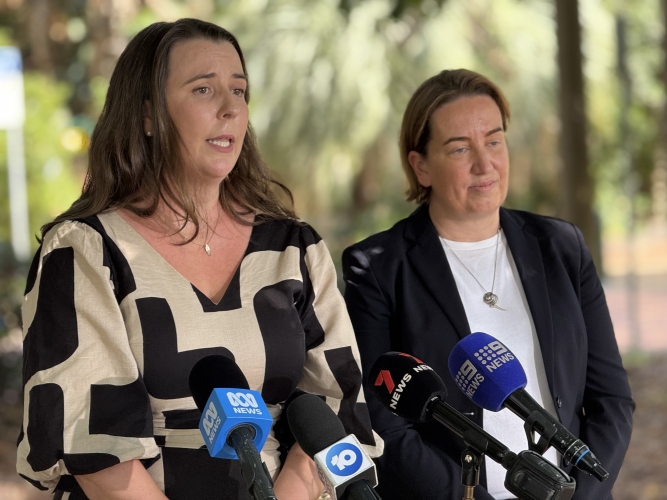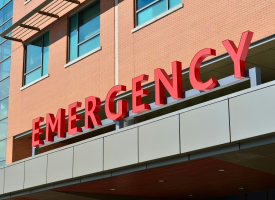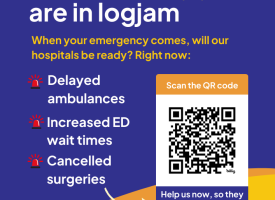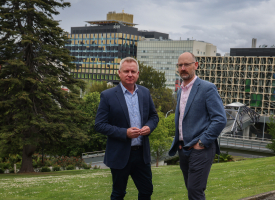Press conference transcript: AMA 2025 Public hospital report card
AMA President Dr Danielle McMullen and AMA (NSW) President Dr Kathryn Austin in Sydney

DANIELLE McMULLEN: We're here today to launch the AMA Public Hospital Report Card. The data shows us what my hospital colleagues have been telling me, that they're working harder and harder with less and less — fighting an endless tide of patients who need their care, and they're doing their very best.
There are some glimmers of hope in the data this year. We're seeing small improvements in the number of patients seen on time and the number of elective surgeries or planned surgeries being completed on time. But unfortunately, our five-year trends are still woeful and we're still seeing our public hospitals under increasing strain.
I hope the improvements this year are the sign of a turning tide but, unfortunately, we can't escape the fact that we're seeing slippages over the five-year interval on all of our hospital markers. Only 55 per cent of emergency department presentations are completed within the recommended four hours, that means patients are waiting far too long for a hospital bed. Also, of emergency department presentations classified as emergency and required to be seen within 10 minutes, a third of those patients are waiting too long.
These aren't just numbers. These are patients presenting with chest pains, severe breathing problems, or potential strokes, who are left waiting far too long for the care they need. And let me be clear, this isn't because our hospital staff aren't doing their very best. It's because our hospitals are stuck in a logjam. They are working their absolute hardest to see patients as quickly as they can, but there's just nowhere to put them.
On a population level, our number of hospital beds has stayed stagnant at its lowest rates in history. We really need all levels of government to pitch in and get back to the table on a national health funding agreement to make sure that we've got certainty and sustainability and appropriate funding for our public hospitals.
The recent injection of some funds by the Commonwealth was welcome but, certainly after the election, more needs to be done to make sure that our public hospitals can deliver that care that patients need.
KATHRYN AUSTIN: We know that, as Danielle has said, there's an incredible challenge across healthcare in this country. We know that our workforce is working harder than ever to deliver the same services with less and less. We know that puts the patient at the centre of incredible challenges.
We know that we need to have once in a lifetime investment into healthcare services to ensure that our workforce can continue to perform excellent medicine. We know that good medicine takes time and there should be investment by these governments to ensure that our patients are not the collateral damage in the system. We can't stress enough the importance of workforce for doctors in this country, to ensure that they are supported to do the jobs to provide the best in evidence-based medicine, and ensure that our country continues the standards of excellence in healthcare that they deserve.
QUESTION: If you don't mind, I might just ask just two specific questions about each of the states. For New South Wales, it's obviously sort of the best performer. Why is that?
DANIELLE McMULLEN: What our Report Card shows is that no state has been immune from the challenges of health funding and health resourcing. New South Wales is amongst the best performers in the country. But even then, we know from on-the-ground reports of doctors working in our public sector, that they are feeling the strain too. And even here, patients are waiting longer than they need to both in emergency departments and for planned surgery.
So certainly, the clear message is that while there are, on certain metrics, some states doing better than others, no state has been able to escape the harms of underfunding.
QUESTION: Queensland, what is it the Queensland State Government needs to do first and foremost? In particular, when it comes to retaining hospital staff, what do they need to do there?
DANIELLE McMULLEN: In Queensland, the numbers are looking rather similar to the rest of the country in that while there's been an improvement in some of the wait times for planned surgery and some of the hospital metrics, they are seeing the number of patients being treated in emergency departments at a 10-year low. That really shows that in all states and territories, including Queensland, we really need investment in our public hospitals to make sure patients can be seen when they need to.
QUESTION: And in Western Australia there's, obviously, an election campaign going on right at the moment. Should the parties be bolder in terms of their commitment to health?
DANIELLE McMULLEN: In WA, what we see is they generally perform on par at national averages, but certainly have a lot of room to catch up to pre-Covid levels in terms of seeing patients on time in ED, and getting them the planned surgery when they need.
With an election coming up in WA, it's really critical that all sides of government take a long, hard look at hospital performance, and make the investments they need to make sure that patients in WA can get care when they need. It's a responsibility of both state and Commonwealth governments to come to the table, invest in our public hospital system, and make sure patients can get that critical care.
QUESTION: I don't have a specific question for either South Australia or Victoria, but could you perhaps just, let me know what you sort of see as the key [indistinct] both states one by one?
DANIELLE McMULLEN: In South Australia, there's been some great news with a major uplift in the number of planned surgery patients getting their surgery on time. But unfortunately, in the emergency departments in South Australia, patients are still waiting too long, and so there is still more work to be done in South Australia.
In Victoria, we've seen some improvements across the board, with most of their emergency department and planned surgery metrics improving compared to last year. The one challenge we still see in Victoria is that when people are overdue for their planned surgery, their average overdue wait time is the longest in the country. So, there's certainly some work still to be done in Victoria, particularly on those planned surgery waitlists.
QUESTION: Just as a general overall comment, or question. Other than throwing more money at the problem, are there things that the state governments and, indeed, the federal government need to be doing to actually more effectively target and tackle these issues around hospital logjams? I mean, as your reports have made clear for years now, these aren't new issues and, to an extent, what the report shows is sort of tinkering at the edges with slight [indistinct] one way or the other, here or there.
DANIELLE McMULLEN: Turning around these figures will take a concerted effort by both state and territory governments and the Commonwealth Government. We need investments in primary care to keep people well and out of hospital, and we recognise that both sides of government have made recent announcements in this space.
We also need investment and support in aged care and community care so that people can be discharged from hospital in a more timely fashion, and make space for those who need to be admitted from the emergency department.
And we've also seen, across all levels of government, that they did spend over a year trying to negotiate a new National Health Reform Agreement. Unfortunately, those negotiations stalled ahead of the election. And while the Commonwealth's investment of some funds into a single year agreement were welcome, we really need our state and territory governments and the Commonwealth Government to urgently get back to that table, negotiate a five-year agreement, so that there's certainty, clarity and appropriate investment with each side paying their fair share to make sure that Australians can get the healthcare they need through the public hospital system.



